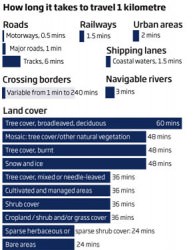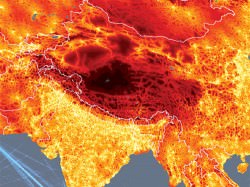[/caption]
According to a new study, less than 10% of the world’s land is more than 48 hours of travel from the nearest city. This doesn’t include air travel, it is ground-travel only (i.e. on foot, train, car, boat, bike, horse, donkey). So no matter where you are in the world, there’s a good chance you can get to somewhere substantially populated within two days. At face-value, this might not seem very important, but when you look at the maps, you see many wilderness locations aren’t quite as remote as we once thought they were. The Amazon Rainforest for example is surprisingly well connected (rivers are quite useful in that respect), and the remote deserts of Africa have a pretty efficient road network.
So, where is the most remote location on Earth? How long would it take to get there?
I can happily say that for 5 months I lived in one of the most remote places in the world. The Norwegian archipelago of Svalbard in the High Arctic turns out to be a very extreme place even if you put the polar bears and -30°C temperatures to one side. No matter how hard you try, it would take 2-3 days by boat to travel from Longyearbyen (on the main island of Spitsbergen) to the Norwegian mainland city of Tromsø. Unfortunately, the number of places around the globe that can boast this are rapidly shrinking.
The fact is, the travel time of any point from the nearest settlement of over 50,000 people using only ground-travel is decreasing rapidly. Transportation infrastructures are spreading and population density is increasing, meaning more people are making bigger cities closer together.

Based on a computer model that calculates the journey time to the nearest city of 50,000+ people taking only land or water. The variables included in this complex model are types of terrain, road, rail and river network access, altitude, terrain steepness and obstacles (such as border crossings). The key conclusions the researchers gained are that less than 10% of the planet’s landmass is more than 48 hours ground-travel away from the nearest city. The Amazon, for example, only has 20% of its landmass more than 2 days away from the nearest Brazilian city (owed primarily to its vast network of rivers).
The most striking maps include the plotting of the busiest waterways (the English Channel, Mediterranean and South China Seas are the most crowded) and the scope of the world’s road network. In fact, it is little wonder the international community is worried about the increasing numbers of Somalian pirate attacks; another very busy shipping lane is sandwiched between Somalia and Yemen (the key route from the Indian Ocean to the Mediterranean).

It is hoped these maps will serve as a baseline for future studies, showing how nations deal with population growth, how nature is being eroded and possibly providing some insight as to how to manage the planet a little better than we are at present…
Source: New Scientist


That’s what I thought when writing the article. However, I’m not familiar with how quickly it would take to travel from the South Pole to the Antarctic coast and then to the nearest city… probably a while! It’s a shame there was no mention about this factor in the research.
Cheers, Ian
I wonder if they did a sensitivity analysis to their 50,000 threshold? If you insisted, for example, that only cities above a million count, does the map change?
What about Atlantica?
There could be no better example of why we are having a problem with global warming than these maps, as the bulk of these travel routes employ gas engines! The thinker the lines of travel, the more CO2 is being put off! This is a very interesting study! Thank you and keep up the good work!
I concur on Antarctica—if we’re talking about “Earth”, technically speaking, then areas like the South Pole would take the crown.
Interesting to see just how remote Tibet is, though.
I stayed in Yap, Micronesia, for a while.
2 flights per week (stop-off en route from Guam to Manila)
definitely no town or city more populous than 50000 people to be reached within two days, other than flying.
And flying, only on a Wednesday or on a Sunday…
nice weather, though, probably nicer than Antarctica or northern Norway. Small breezy island near the Equator, never too hot, never too humid.
Downtown LA
Use Google, look for “dan tillmanns”, Take the Visit to Old Los Angeles.
This is bad science that ignores too many data sets.
Still, it does indicate how overpopulated the Earth is. I sense a plague coming.
I really do believe that global overpopulation should be just as hot an issue as global climate change. I see the t.v. reality shows on networks here in the States about families with 8-18 children and I shake my head. They’re not condoning people to have alot of children, but it’s sure not stopping them. My big issue with people having multiple sets of children at once is the use of drugs and in-vitro fertilization. Octo-Mom in California is a glaring example of this. 8 children at once!!! Un-natural for a human being!!! If you can’t have children, I’m sorry. That is very sad. You also shouldn’t put 8 children in a position of poverty and if you really want children that badly, you should adopt. I know everyone has the “right” to have a child, but if you naturally cannot have children, deal with it like you aren’t a spoiled piss-pot. Suck it up and adopt a child that is already born and needs a parent.
I though Pitcairn Island was the most remote place on Earth?
I’m w/ Antarctica !!!.
Eric,
Have you adopted?
I suspect that Tristan da Cunha is the most remote location – certainly the longest travel time since there’s no airport or air service.
On the heat map it looks to me like somewhere in Greenland is the most remote.
I think you’re right Chris B.. St. Helena is quite remote as well.
any of you ever heard of the island of Unst? It is the most northern of the Shetland Islands – population less than 20 when I was last there 25 years ago; 25,000 sheep. About 5 miles long and a mile across. After you travel to the top of the British Isles, take a boat from Inverness to Lerwick at the base of the Shetland Islands. Then traverse about 5 islands – a total distance of about 25 miles, each island gets smaller and more remote as you travel north – and the north sea wind never stops. Quite an adventure – plan on two days from Inverness in each direction going over land…
Where exactly is ATLANTICA anyway???
They probably left Antarctica off the survey due to the fact that there isn’t any reason to travel there for most of the population, other than scientists and research adventures.
But of course Atlantica would be the most remote place to get to due to it being in someone else’s mind – can you say IMAGINARY?
What really matters, is how far is it to Starbucks?
@ Zibit:
No I haven’t adopted and I’m not adopted. I just feel like as a species we’ve become so “entitled” and feel like we all have the same right to have kids. Maybe it’s true that we do have the right to have kids. But nature has it’s reasons why some people can’t. So that’s why I feel like instead of proving to everyone that “See, I CAN have kids!”, think of the kids that are already here on the planet, that get stuck going from one foster family to another and take a chance on them instead of a biological crapshoot.